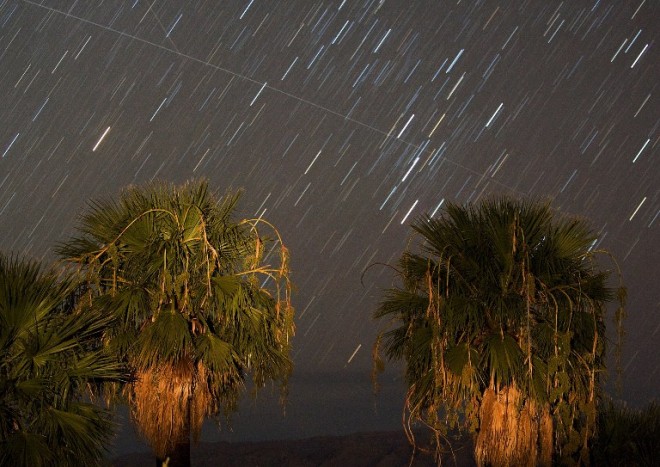Cloudy skies may block view of meteor showers

Perseid meteors streak across the sky early Aug. 12, 2008, near Rogers Spring in the Lake Mead National Recreation Area, Nevada. The annual Perseid meteor shower will have its peak from 11 p.m. on Wednesday, Aug. 12, 2015, to 4 a.m. on Thursday, the weather bureau said on Monday. AFP PHOTO/ETHAN MILLER/GETTY IMAGES
Keep your fingers crossed and hope for clear skies so you can watch a stellar show from late night on Wednesday until sunrise on Thursday.
The annual Perseid meteor shower will have its peak from 11 p.m. on Wednesday to 4 a.m. on Thursday, the weather bureau said on Monday.
The Philippine Atmospheric, Geophysical and Astronomical Services Administration (Pagasa) advised stargazers to look up at 1 a.m. on Aug. 13 when at least 50 shooting stars streak across the sky in an hour.
Named after the constellation Perseus, where the meteors appear to originate, the shower features fast and bright meteors that leave trails of light.
Another unique feature of Perseids is their fireballs, which are larger explosions of light and color that can persist longer than an average meteor streak, according to the National Aeronautics and Space Administration.
Cloudy skies
Barring a cloudy sky, this year’s Perseid meteor shower would be seen clearly in the Philippines since a waning crescent moon will leave the sky dark.
Unfortunately for the country, the meteor shower occurs during the rainy season when the country frequently experiences cloudy skies.
In fact Pagasa has reported cloudy skies over much of the country the past several days.
“It would have been a good time to watch since we expect little or no light from the moon. But the sky may be a bit cloudy at this time of the year,” said weather observer Rex Guerrero of the Pagasa astronomy division.
Eastern horizon
“But we might have some luck since the typhoon (‘Hanna’) has just left. Let’s hope our skies will be clear,” he added.
Guerrero advised stargazers to look up the eastern horizon where the constellation of Perseus is located since that is where the meteors radiate from.
Under clear and dark skies with no pollution, observers could expect to see at least 50 up to 100 shooting stars in an hour.
No need for binoculars
Unlike some celestial events, one doesn’t need special technology to watch the Perseids unfold. It is best to find a wide, open space away from tall buildings or trees, and with as little artificial light as possible.
“The more of the sky you can see the better,” said astronomer Affelia Wibisono from the Royal Observatory Greenwich. “You don’t need any binoculars or telescopes. It’s actually better if you use your eyes.”
The Perseid meteor shower takes place when debris from the Comet Swift-Tuttle slam into the Earth’s upper atmosphere when the planet crosses the orbit of the comet.

Other meteor showers include Lyrids in April, Eta Aquarids in May, Delta Aquarids in July and Orionids in October.
Cosmic debris
These meteors are caused by streams of cosmic debris or dust particles called meteoroids entering Earth’s atmosphere at extremely high speeds on parallel trajectories.
When the Earth passes through one of these debris streams, tiny dust particles called meteoroids burn up in the atmosphere, producing a streak of light.
The Perseids are also known as “the tears of St. Lawrence” in honor of a martyred Christian saint. St. Lawrence was an early Christian deacon tortured to death by the Romans in AD 258. His saint’s day of Aug. 10 coincides with the Perseids buildup.–With reports from Kathleen de Villa, Inquirer Research, and AFP
RELATED STORIES
Now showing for stargazers: Meteor shower